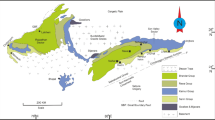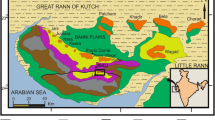Abstract
Thick conglomerate and sandstone lithofacies of Yingcheng Formation in Changling Sag are tight gas reservoirs. The formation contains a fair amount of volcanic clasts and accumulated in a deltaic system that spans from delta plain to prodelta depositional setting. High-quality reservoirs are only a small fraction of these thick siliciclastic rocks. Petrographic analysis has been used to assess diagenetic processes, paragenetic sequence, and their effects on the reservoir qualities. The major loss of primary porosity is due to compaction along with grain-coating, pore-filling clay, and quartz cements. Alteration of volcanic rock fragments supplied alkali cations which favored formation of chlorite, smectite, and zeolite cements. The thickness of the chlorite coating decreases from the delta plain to the distal part of the delta front. On the contrary, the content of the zeolite cement increases toward the distal part of the delta front. Quartz and feldspar cements were ubiquitous due to high SiO2 concentration and alkali cations. Early dissolution of volcanic rock fragments and feldspars by freshwater increased porosity but did not contribute much to the permeability because pore-throats are predominantly occluded with clay and pseudomatrix. Late-stage dissolution of the zeolite cement was caused by organic acid expelled from maturation of organic matter. Although the reservoirs with chlorite coatings have moderate porosity, the permeability in situ is very low and pore-throat sizes are small. The high-quality reservoirs are medium- to fine-grained zeolite-dissolved sandstones developed in the distal part of the delta front and shallow lacustrine.















Similar content being viewed by others
References
Ajdukiewicz JM, Lander RH (2010) Sandstone reservoir quality prediction: the state of the art. AAPG Bull 94(8):1083–1091
Berger A, Gier S, Krois P (2009) Porosity-preserving chlorite cements in shallow-marine volcaniclastic sandstones: evidence from Cretaceous sandstones of the Sawan Gas Field, Pakistan. AAPG Bull 93(5):595–615
Bjørlykke K (2010) Petroleum geoscience: from sedimentary environments to rock physics. Springer, Berlin 508 p
Bjørlykke K (2014) Petroleum geoscience: from sedimentary environments to rock physics—second edition. Springer, Berlin 662 p
Boggs S (2009) Petrology of sedimentary rocks, 2nd edn. Cambridge University Press, Cambridge 600 p
Carvalho ADSG, Ros LFD (2015) Diagenesis of Aptian sandstones and conglomerates of the Campos Basin. J Pet Sci Eng 125(1):189–200
Chipera SJ, Goff F, Goff CJ, Fittipaldo M (2008) Zeolitization of intracaldera sediments and rhyolitic rocks in the 1.25 Ma lake of Valles Caldera, New Mexico, USA. J Volcanol Geotherm Res 178(2):317–330
Chuhan FA, Kjeldstad A, Bjørlykke K, Høeg K (2002) Porosity loss in sand by grain crushing—experimental evidence and relevance to reservoir quality. Mar Pet Geol 19(1):39–53
Ding XQ, Zhang SN, Han MM (2013) The role of provenance in the diagenesis of siliciclastic reservoirs in the Upper Triassic Yanchang Formation, Ordos Basin, China. Pet Sci 10(2):149–160
Ehrenberg SN (1990) Relationship between diagenesis and reservoir quality in sandstones of the Garn Formation, Haltenbanken, Mid-Norwegian Continental Shelf. AAPG Bull 74(10):1538–1558
Ehrenberg SN (1993) Preservation of anomalously high porosity in deeply buried sandstones by grain-coating chlorite: examples from the Norwegian Continental Shelf. AAPG Bull 77(7):1260–1286
Fawad M, Mondol NH, Jahren J, Bjørlykke K (2010) Microfabric and rock properties of experimentally compressed silt-clay mixtures. Mar & Pet Geol 27(8):1698–1712
Fawad M, Mondol NH, Jahren J, Bjørlykke K (2011) Mechanical compaction and ultrasonic velocity of sands with different texture and mineralogical composition. Geophys Prospect 59(4):697–720
Feng ZQ (2006) Exploration potential of Qingshen gas field in the Songliao Basin. Nat Gas Ind 26(6):1–5
Feng ZH, Yin CH, Lu JM, Zhu YK (2013) Formation and accumulation of tight sandy conglomerate gas: a case from the Lower Cretaceous Yingcheng Formation of Xujiaweizi fault depression, Songliao Basin. Pet Explor Dev 40(6):696–703
Folk RL, Andrews PB, Lewis DW (1970) Detrital sedimentary rock classification and nomenclature for use in New Zealand. N Z J Geol Geophys 13(4):937–968
Ge RF, Zhang QL, Wang LS, Xie GA, Xu SY, Wang XY (2010) Tectonic evolution of Songliao Basin and the prominent tectonic regime transition in Eastern China. Geol Rev 56(2):180–195
Huang WB, Hersi OS, Lu SF, Deng SW (2017a) Quantitative modeling of hydrocarbon expulsion and quality grading of tight oil lacustrine source rocks: case study of Qingshankou 1 Member, Central Depression, Southern Songliao Basin, China. Mar Pet Geol 84(6):34–48
Huang W, Lu S, Osman SH (2017b) Quality grading system for tight sandstone reservoirs in the Quantou 4 Member, Southern Songliao Basin, Northeast China. Interpretation 5(4):1–60
Jin HN, Boles JR (1993) Origin of zeolite cements in the Miocene sandstones, North Tejon Oil Fields, California. J Sediment Res 63(2):248–260
Lander RH, Walderhaug O (1999) Predicting porosity through simulating sandstone compaction and quartz cementation. AAPG Bull 83(3):433–449
Lu JM, Liu C (2016) Accumulation conditions and resource potential of tight glutenite gas in fault depression basins: a case study on Lower Cretaceous Shahezi Formation in Xujiaweizi fault depression, Songliao Basin. China Pet Explor 21(2):53–60
Ma YS, Guo TL, Zhao XF, Cai XY (2008) The formation mechanism of high-quality dolomite reservoir in the deep of Puguang Gas Field. Sci China Ser D Earth Sci 51(1):53–64
Macquaker JHS, Taylor KG, Keller M, Polya DA (2014) Compositional controls on early diagenetic pathways in fine-grained sedimentary rocks: implications for predicting unconventional reservoir attributes of mudstones. AAPG Bull 98(3):587–603
Mariner RH, Surdam RC (1970) Alkalinity and formation of zeolites in saline alkaline lakes. Science 3961:977–980
Pittman ED, Larese RE (1991) Compaction of lithic sands: experimental results and applications. AAPG Bull 75(8(8)):1279–1299
Remy RR (1994) Porosity reduction and major controls on diagenesis of Cretaceous–Paleocene volcaniclastic and arkosic Sandstone, Middle Park Basin, Colorado. J Sediment Res 64(4):797–806
Schmidt V, Mcdonald DA (1979) The role of secondary porosity in the course of sandstone diagenesis. Spec Publ 26:175–207
Shanley KW, Cluff RM, Robinson JW (2004) Factors controlling prolific gas production from low-permeability sandstone reservoirs: implications for resource assessment, prospect development, and risk analysis. AAPG Bull 88(8):1083–1121
Spencer CW (1989) Review of characteristics of low-permeability gas reservoirs in Western United States. AAPG Bull 73(5):613–629
Sun YH, Chen YB, Li XS, Sun JG, Fu XF (2013) Evolutionary sequence of faults and the formation of inversion structural belts in the northern Songliao Basin. Pet Explor Dev 40(3):275–283
Surdam RC, Yin P (1994) Organic acids and carbonate stability, the key to predicting positive porosity anomalies. Springer, Berlin, p 448
Taylor TR, Giles MR, Hathon LA, Espejo IS (2010) Sandstone diagenesis and reservoir quality prediction: models, myths, and reality. AAPG Bull 94(8):1093–1132
Xu CX, Ma PS, Lai LB, Sun YH, Li ZC (2014) Sensitivity parameters of tight sand gas: a case study of Lower Cretaceous Yingcheng Formation of Yingtai gas field in Songliao Basin, NE China. Pet Explor Dev 41(6):712–716
Xue T, Liang JP, Lin CM, Qiao W, Tang ZG (2009) Reservoiring laws and potentials of oil-gas exploration in the northern Songliao Basin. Chin J Geol 44(2):399–408
Yang P, Ding XQ, Han MM, Zhang SN (2016) Deep reservoir quality prediction using diagenesis: a case study from Zhanjiaduo Oilfield of Subei Basin, China. Arab J Geosci 9(3):211–222
Yin JY, Liu HF, Chi HJ (2002) Evolution and gas accumulation of Xujiaweizi depression in Songliao Basin. Acta Pet Sin 23(2):26–29
Zhang XZ, Guo ZD, Zeng Z, Fu QL, Pu JB (2015) Dynamic evolution of the Mesozoic–Cenozoic basins in the Northeastern China. Earth Sci Front 22(3):88–98
Zhu SF, Zhu XM, Wu D, Liu YH, Li PP, Jiang SX, Liu XC (2014) Alteration of volcanics and its controlling factors in the Lower Permian reservoirs at northwestern margin of Junggar Basin. Oil Gas Geol 35(1):77–85
Acknowledgements
We would like to express our thanks to the Northeast Oil and Gas Company of SINOPEC for the permission to publish this work. This study was financially supported by the National Science Foundation of China (41302115), Major Project from Sichuan Province Education Department (16ZA0089), Scientific Research Team from CDUT (KYTD201401), and Teachers Found from CDUT (JXGG201403). Data analysis, interpretation, and preparation of the manuscript were done during the senior author’s visit at the Department of Geology, University of Regina, Canada.
Author information
Authors and Affiliations
Corresponding author
Rights and permissions
About this article
Cite this article
Ding, X., Hersi, O.S., Hu, X. et al. Diagenesis of volcanic-rich tight sandstones and conglomerates: a case study from Cretaceous Yingcheng Formation, Changling Sag, Songliao Basin, China. Arab J Geosci 11, 287 (2018). https://doi.org/10.1007/s12517-018-3628-x
Received:
Accepted:
Published:
DOI: https://doi.org/10.1007/s12517-018-3628-x




